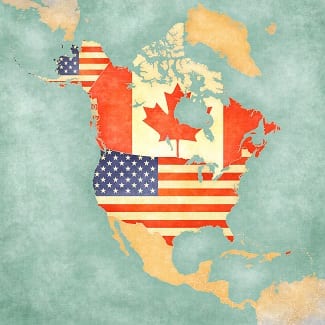Canadian Exports to United States Are Being ‘Trumped’ by Mexico

2016 wasn’t a great year for Canadian exports destined for the United States. In fact, Canadian exports decreased by 7.7%, despite a relatively low dollar value that should have increased competitiveness. Canadian exports to the U.S. have suffered a decline since early in 2015 while other top American trade partners (China, Mexico) have remained much more stable.
Canada’s declining share of U.S. exports hit a critical point late in 2016 when Mexico, formerly the third-largest exporter, surpassed Canada to overtake the #2 spot.
It will be interesting to watch how Donald Trump’s presidency might affect these trade relationships into the future. In 2017 we could see the U.S. make new trade deals that align them towards cheap labour, or perhaps we could see a greater Made-in-America approach. These strategies would have vastly different outcomes for Canadian export competitiveness.
Either way, Canadian businesses must be ready to increase their exports with the United States and other nations. It’s critical for Canada’s economy and the financial success of individual companies alike. Luckily, companies can drive more revenue from international clients with the support of Canadian government funding.
Free Download: The Canadian Business Guide to Export Expansion
Mexico is More Competitive than Canada as a Manufacturer of Goods
From January 1 to October 31 2016, Canadian exports to the United States totalled $230 billion USD. During the same time period this year, Mexico has exported approximately $245 billion USD in goods across the border. This $15 billion (and growing) trade gap, pointed out by Bloomberg News, is just one metric that shows how Canadian exporters are losing international competitiveness.
The automotive sector is a main reason for this growing divide. An increasing amount of automotive manufacturing investments are flowing south of the border while researching and engineering is being done in Canada. Although Canada still has a role in the automotive industry, it’s changing quickly and defined more by knowledge tangible product exports.
Labour and energy costs are limiting American exports from manufacturing and other traditional export industries. Generally, it’s too expensive for manufacturers of goods to keep up with low-cost alternatives like China and Mexico. The economies are structured differently.
Even with a weak Canadian dollar, unit labour costs have increased by 64% since 2002. By contrast, Mexico’s labour rates have increased by approximately 0.5% per year.
How Trump Could Impact Trade Relationships with Canada/Mexico
Then again, none of these historical trends could soon matter if Donald Trump’s influence begins to dramatically shift American trade relationships. Based on his campaign platform, it seems impossible for trade with Mexico to remain the same – but how will it ultimately influence exports with Canada?
There are two major trends that could increase Canadian exports with Trump’s arrival as President.
- The implementation of a 35% tariff on Chinese products would significantly reduce China’s market control. Fewer products coming over from China would increase reliance on North American manufacturing, creating additional opportunities for Canadian businesses.
- The re-negotiation of trade agreements that could support greater American-Canadian trade cooperation. It’s still too tough to determine whether re-visiting NAFTA would be a good move for Canada, although for now it still has the potential to be a success.
Related Blog: 5 Ways Donald Trump’s Presidency Would Impact Canadian Business
How Canadian Businesses Can Increase Export Revenue
Exporters may increase their international competitiveness by better aligning themselves to Canada’s knowledge economy. This means investing in innovative, productivity-boosting equipment, training employees to be more effective than cheap labour, and exploring new export markets.
Research & Development and New Equipment Purchases
If inexpensive labour is Mexico’s plan to bolster investment and American exports, then Canada must take a path of delivering higher quality and value to customers. To do this, exporters should be focused on strategies to boost their innovation and productivity, including purchasing advanced equipment or researching/developing their own.
Purchasing innovative technologies are one way of accomplishing this. By having access to machines that have better abilities and faster output, Canadian firms can generate a better product in less time. Although there will still be a Mexican market for cheap goods, Canada can compete for high-value export relationships.
Another strategy is to develop innovative technologies on your own, using a combination of internal and contracted labour. If companies have a strong internal engineering or R&D team who can oversee these types of projects, it’s a great way to build unique advantages.
Canadian government funding is even available to support technology adoption and research projects. Although capital investment grants are mostly available on the provincial level, federal funding can be awarded for technical research projects through the Industrial Research Assistance Program (IRAP).
IRAP research grants help businesses to overcome internal technical challenges by offsetting up to 50-80% of labour costs. This helps companies improve project return-on-investment (ROI) and ultimately helps to bring the innovation to market faster.
Training Employees to Maximize Skills, Productivity
Likewise, if Canadian labour costs more than Mexican labour does, then Canadian workers should be more skilled and productive. The responsibility to develop a more skilled workforce ultimately falls on employers though, and it’s time for them to enhance competitiveness by investing in employee training programs.
Unfortunately, third-party training can be costly when implemented across a team or business as a whole. Hiring trainers, paying for tuition, and affording learning materials can be too expensive for some firms, especially when the financial return on their training is unknown.
Luckily, some employee training programs may be able to receive Canadian government funding to reduce the cost of implementation. One of the programs available nationally is the Canada Job Grant, an opportunity that provides employers with up to 50-83% of training costs to a maximum $10,000 per trainee.
Developing New Export Trade Relationships
Perhaps most importantly, Canadian businesses need to actively explore new export markets and trade relationships. It’s not good enough to have a competitive product and hope that target customers find you – companies must actively search for new international customers to grow and succeed.
Attending industry-specific trade shows in new/existing international markets will help to increase exposure and connect you to support services that can strengthen international operations. Starting your market expansion project by attending or exhibiting at trade shows is an excellent, low-risk strategy that can help ease your transition.
The federal government’s CanExport program provides trade show grants to small businesses across the country so that they can afford to participate in international trade events. Canadian companies can use this government funding to offset a portion of project costs as long as the company has earned less than 10% or $20,000 of total international revenues in that market within the last 24 months.
CanExport trade show grants may provide up to 50% of project expenses to a maximum $50,000 in non-repayable funding. This amount can include trade show fees, airfare, and translation of marketing materials for the new market.
Access Resources and Funding for Canadian Exporters
Small and mid-sized Canadian businesses may continue learning about export market grants and other exporting resources by downloading Mentor Works’ Small Business Guide to Export Expansion.

